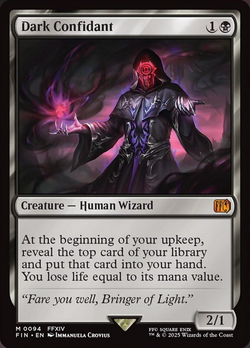Dark Confidant is coming to Standard and Pioneer. This isn’t a simulation — another historic Magic staple is coming to the newer formats: Final Fantasy is bringing the first reprint of one of the game’s most powerful two-drops to a Standard set since its original release in 2005.

Tierlist
No Rank
Grade it yourself
*This site contains affiliate links for which we may be compensated
Fifteen years have passed. Since then, the power level of Magic: The Gathering has grown considerably, and Bob, as he was known, has not been as relevant in the competitive since Modern Horizons power crept him out. And just like Liliana of the Veil in Dominaria United, Confidant will now have to pass the test of fire in Standard and Pioneer, but can one of the greatest staples of all time still find a home in the newer formats?
Dark Confidant — A Historical Analysis
Dark Confidant was originally released in Ravnica: City of Guilds in 2005 and was part of the Invitational program, a professional tournament where the champion could participate in the design of a Magic card for future expansions, where his face would be immortalized on that card — Bob Maher was the mind behind Dark Confidant, and for this reason, the creature is commonly known as Bob.
Just like Umezawa’s Jitte in the previous block, Dark Confidant saw play in every competitive formats since its release, but its first highlight was in Extended, where it became the main source of card advantage available— either alone, or through the interaction with Sensei’s Divining Top that allowed to manipulate the top and avoid the damage caused by its ability.
Over the years, Bob has become a multi-format staple, but its biggest impact has continued to be in Extended, where it has been in every archetype category, from Aggro like Zoo to combos like Dark Depths, and even Control or Tempo lists like CounterTop Goyf.
Ad
After the format's demise, Bob soon became a staple in the format that would replace Extended, Modern. The card became a mainstay of Jund and other 
Dark Confidant remained a Jund staple until the release of Modern Horizons. There, the power creep that the expansion brought had put its position in check, especially because the archetype in which it was inserted gained a two-drop that had more inherent qualities and countered all the X/1 creatures in the format: Wrenn and Six, and with Modern Horizons II bringing Ragavan, Nimble Pilferer and the Evokers, that had high mana values, in addition to Orcish Bowmasters in Lord of the Rings as another predator of X/1 creatures, Bob fell into oblivion.

Today, it is still possible to find Dark Confidant in some Modern and Legacy lists, but hardly as a pillar or as the staple that it was. Some Jund lists have reintroduced copies of it in some variants after Grief and Fury were banned, while in Legacy, Dark Depths still counts it as its main source of card advantage in the 
Ad
Getting the most out of Dark Confidant
Dark Confidant is one of those cards that creates the “snowball effect”: every turn it stays in play, it generates more value for its controller, often requiring immediate responses from the opponent so as not to be buried in card advantage.
In theory, it was created as an alternative to Phyrexian Arena, with the advantage of costing less and having a more punishing drawback for decks that traditionally wanted Arena, but it ended up gaining the spotlight for being more cost-efficient if you respected its limitations instead of letting them be imposed on you. Like other cards, Bob was one of the biggest motivators for betting on mana efficiency.

For your list to fully support him and get the most value, there are a few prerequisites:
Ad
Dark Confidant in Standard
It sounds crazy, but the biggest problem with Dark Confidant in Standard and Pioneer is essentially the same: waiting a turn. If we look at the best decks today, a lot can happen in that time: a Heartfire Hero could be attacking you with Manifold Mouse and Monstrous Rage, the opponent could play a Sunpearl Kirin at the end step to play Kaito, Bane of Nightmares for Ninjutsu and still bounce a Stormchaser’s Talent, or already have an Abhorrent Oculus in play creating a 2/2 on the board the next turn — It’s hard for a single turn with Dark Confidant to be enough to recover from these.

Even if the opponent doesn't have an explosive early game, Bob needs a more specific archetype to work against the current Metagame, and none of the strategies that would easily support him want him for different reasons. Orzhov Bounce, for example, runs Temporary Lockdown and its combination with Nurturing Pixie to reuse several ETBs in the same turn in some games while it is a cheap sweeper in others, not to mention that the main win condition involves Unholy Annex, which, if revealed with Dark Confidant, deals eight damage to its controller.

Unholy Annex is also a deterrent to Dark Confidant in more traditional Midranges, where the higher curve might not be an issue with other cards like Sheoldred, the Apocalypse, but eight damage in a more aggressive Metagame easily spells defeat — and between a 2/1 creature that dies to Torch the Tower or an enchantment that drains life from the opponent while creating a 6/6 on the board, these archetypes are likely to prefer the latter.
Bob can find space in Dimir lists, which don't have Unholy Annex and play plenty of cards with lower mana value, despite usually having eight four-drops between Enduring Curiosity, Kaito, Bane of Nightmares and Sheoldred, the Apocalypse — another challenge for him in these cases also involves Preacher of the Schism, whose body matters in the current Metagame as it dodges Lightning Strike, Torch the Tower and Cut Down while blocking well and trading with any creature in combat.

Ad
But perhaps the mistake is in considering Dark Confidant only for Midrange decks. Aggro lists have also used it in the past and usually carry the low curve necessary to get the most out of it. With other creatures with cheap two-for-one effects or a faster clock, he can generate a steady stream of card advantage for his controller to never run out of steam — while the mice package might not be the ideal home, other versions of Aggro could be born from the inherent advantages Bob offers.

Not to mention other low-mana value archetypes that have benefited simply by including him in their lists. Raise the Past variants, for example, benefit greatly from a two-mana creature that generates an extra draw every turn without any additional conditions, and the life loss is easy to work around in this list.
The recent Insidious Roots variants also fit into this category, although they have a potentially bad synergy with Dark Confidant due to Overlord of the Balemurk, which, despite being commonly cast for two mana, has a total value of five. Still, cards like Scavenging Ooze can easily bypass the new creature's life loss.
Dark Confidant in Pioneer
All the possibilities mentioned for Dark Confidant in Standard apply to some extent in Pioneer, but here it has some new challenges and possibilities.

Pioneer's mana curve can go much lower in the Midrange: except for Unholy Annex, Rakdos, for example, only runs Sheoldred, the Apocalypse and Fable of the Mirror-Breaker as cards with a mana value higher than two, and replacing Annex with Bob would be the obvious path for those who want to take advantage of the new card — the question is whether it is worth giving up Annex's interactions with Mutavault as another victory line for just one mana per turn.
Ad

We can't forget about Sacrifice decks either. In addition to easily compensating for the life loss with Cauldron Familiar, these naturally have a very low mana curve except for Ygra, Eater of All, which if resolved will usually win the game — in addition, Final Fantasy also brings Sephiroth, Fabled SOLDIER to the deck, which also compensates for the life loss. While he probably won't replace Mayhem Devil, Sephiroth could make a big difference in the Golgari variants.

Other strategies today in the lower tiers can take advantage of Dark Confidant in different ways: Waste Not is another archetype that can reduce the mana curve to accommodate the card while still taking advantage of Sheoldred, the Apocalypse and other cards with mana value up to four, while Cori-Steel Cutter and a lower mana curve with Soul-Scar Mage and Wizard's Lightning would offer more aggressive openings while Dark Confidant replenishes its owner's hand every turn.
Bob could also work in Humans, since he shares the same creature type and the archetype naturally tends to use cards with lower mana value, and could make the most of the mix of lineage interactions with a constant source of card advantage in the same slot.
Wrapping Up
Dark Confidant is a legend from times gone by, and the fact that we have doubts about its potential for play in 2025 shows how much Magic's Power Creep has grown over this decade. It's a sign of how, just like when it was released in 2005, times change. Excellent cards lose ground, and the natural progression of complex mechanics and exciting abilities slowly deteriorates the pillars that once defined the structure of what made a card good or even too strong for the game.
Bob, now as an Ascian, has potential. There are places where it could work, but there are also circumstances in both Standard and Pioneer today that doesn't align in its favor—it'll definitely be the first card to be ostensibly tested when Final Fantasy comes out on June 13, but until then, we can only imagine what to make of it and reminisce about the days when having a Dark Confidant on the board meant being the king of card advantage.
Ad
Thanks for reading!



 Ebay.com
Ebay.com  Cardkingdom
Cardkingdom  TCG Player
TCG Player 




— Comments0
Be the first to comment